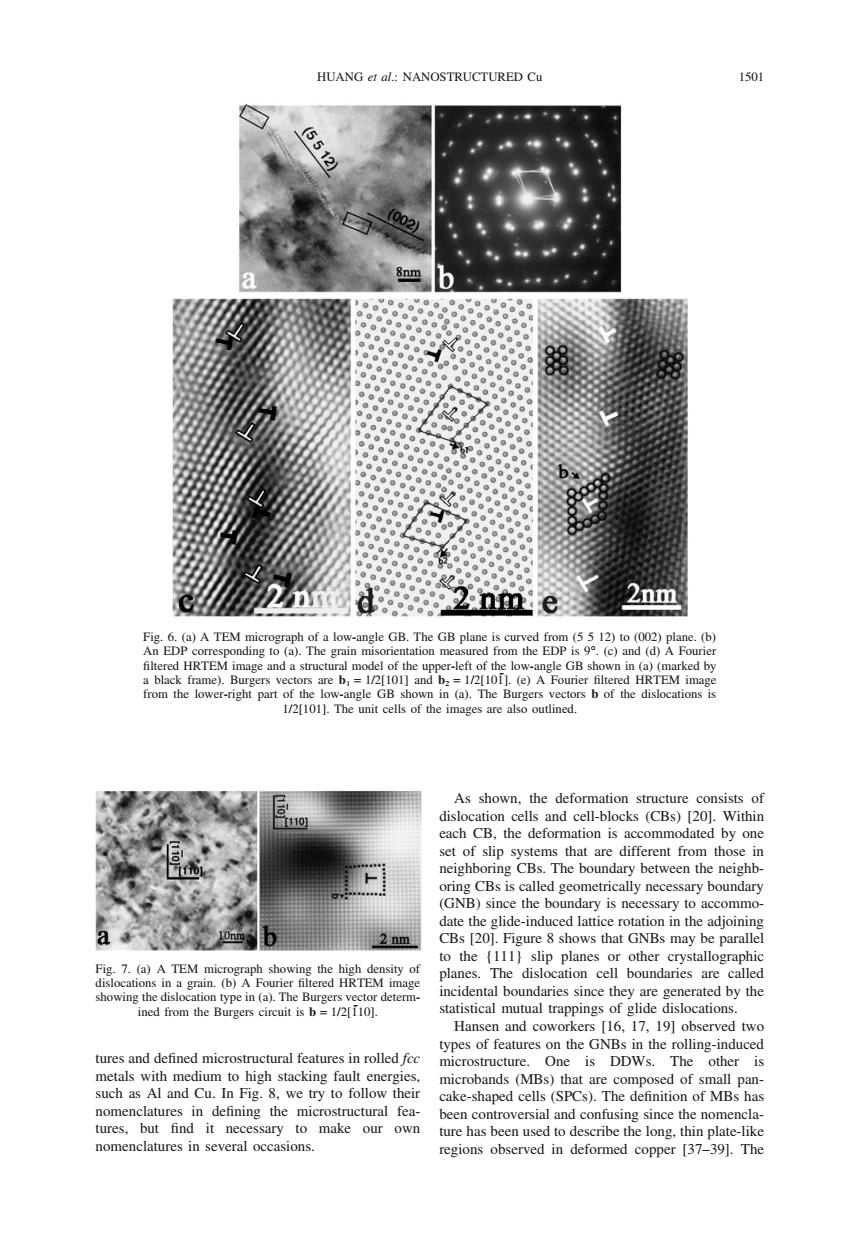正在加载图片...

HUANG et al:NANOSTRUCTURED Cu 1501 55 002 nm 2nm Fig.6.(a)A TEM micrograph of a low-angle GB.The GB plane is curved from(55 12)to (002)plane.(b) An EDP corresponding to (a).The grain misorientation measured from the EDP is 9.(c)and (d)A Fourier filtered HRTEM image and a structural model of the upper-left of the low-angle GB shown in (a)(marked by a black frame).Burgers vectors are b =1/2[101]and b2=1/2[101].(e)A Fourier filtered HRTEM image from the lower-right part of the low-angle GB shown in (a).The Burgers vectors b of the dislocations is 1/2[101].The unit cells of the images are also outlined. As shown.the deformation structure consists of 110 dislocation cells and cell-blocks (CBs)[20].Within each CB,the deformation is accommodated by one set of slip systems that are different from those in neighboring CBs.The boundary between the neighb- oring CBs is called geometrically necessary boundary (GNB)since the boundary is necessary to accommo- date the glide-induced lattice rotation in the adjoining a CBs [20].Figure 8 shows that GNBs may be parallel to the (111}slip planes or other crystallographic Fig.7.(a)A TEM micrograph showing the high density of planes.The dislocation cell boundaries are called dislocations in a grain.(b)A Fourier filtered HRTEM image showing the dislocation type in (a).The Burgers vector determ- incidental boundaries since they are generated by the ined from the Burgers circuit is b 1/2[110]. statistical mutual trappings of glide dislocations. Hansen and coworkers [16,17,19]observed two types of features on the GNBs in the rolling-induced tures and defined microstructural features in rolled fcc microstructure.One is DDWs.The other is metals with medium to high stacking fault energies, microbands(MBs)that are composed of small pan- such as Al and Cu.In Fig.8,we try to follow their cake-shaped cells(SPCs).The definition of MBs has nomenclatures in defining the microstructural fea- been controversial and confusing since the nomencla- tures,but find it necessary to make our own ture has been used to describe the long,thin plate-like nomenclatures in several occasions. regions observed in deformed copper [37-39].TheHUANG et al.: NANOSTRUCTURED Cu 1501 Fig. 6. (a) A TEM micrograph of a low-angle GB. The GB plane is curved from (5 5 12) to (002) plane. (b) An EDP corresponding to (a). The grain misorientation measured from the EDP is 9°. (c) and (d) A Fourier filtered HRTEM image and a structural model of the upper-left of the low-angle GB shown in (a) (marked by a black frame). Burgers vectors are b1 = 1/2[101] and b2 = 1/2[101¯]. (e) A Fourier filtered HRTEM image from the lower-right part of the low-angle GB shown in (a). The Burgers vectors b of the dislocations is 1/2[101]. The unit cells of the images are also outlined. Fig. 7. (a) A TEM micrograph showing the high density of dislocations in a grain. (b) A Fourier filtered HRTEM image showing the dislocation type in (a). The Burgers vector determined from the Burgers circuit is b = 1/2[1¯10]. tures and defined microstructural features in rolled fcc metals with medium to high stacking fault energies, such as Al and Cu. In Fig. 8, we try to follow their nomenclatures in defining the microstructural features, but find it necessary to make our own nomenclatures in several occasions. As shown, the deformation structure consists of dislocation cells and cell-blocks (CBs) [20]. Within each CB, the deformation is accommodated by one set of slip systems that are different from those in neighboring CBs. The boundary between the neighboring CBs is called geometrically necessary boundary (GNB) since the boundary is necessary to accommodate the glide-induced lattice rotation in the adjoining CBs [20]. Figure 8 shows that GNBs may be parallel to the {111} slip planes or other crystallographic planes. The dislocation cell boundaries are called incidental boundaries since they are generated by the statistical mutual trappings of glide dislocations. Hansen and coworkers [16, 17, 19] observed two types of features on the GNBs in the rolling-induced microstructure. One is DDWs. The other is microbands (MBs) that are composed of small pancake-shaped cells (SPCs). The definition of MBs has been controversial and confusing since the nomenclature has been used to describe the long, thin plate-like regions observed in deformed copper [37–39]. The